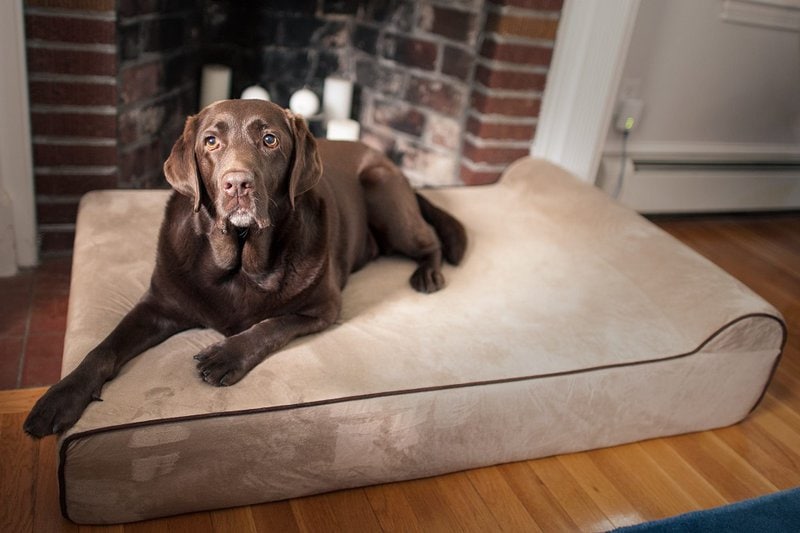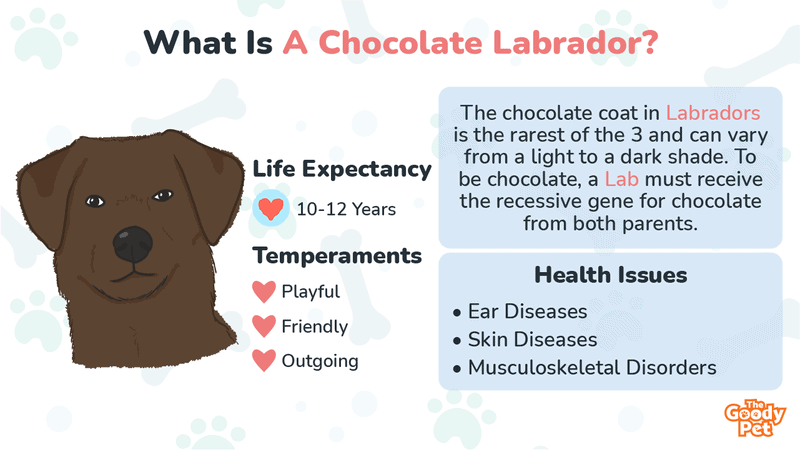If you are thinking of getting a Labrador Retriever, you should know that the sturdy and friendly Lab has all the physical and personality traits you could want in a dog. That explains why America’s Sweetheart has maintained the top slot on AKC’s list of most popular dogs for the past 30 years (since 1991). But when it comes to color, you can only choose between black, yellow, and chocolate.
The chocolate coat in Labradors is the rarest of the 3 and can vary from a light to a dark shade. To be chocolate, a Lab must receive the recessive gene for chocolate from both parents.
There’s a lot more you need to know to fathom the characteristics of the rare and unique Chocolate Lab. Not to worry though, we have every detail regarding the coat color, personality, and other characteristics and care requirements of the Chocolate Lab in this complete breed guide. Keep reading!
| LIFE SPAN | 10 to 12 years |
| PURCHASE PRICE | $600 to $2,400 |
| MONTHLY MAINTENANCE | $100 to $200 |
| CAN LIVE IN APARTMENT | Yes |
| SHEDDING | High (double coated) |
| EXERCISE NEEDS | High |
| ENERGY LEVEL | High |
| BARKING LEVEL | Low |
| DROOLING LEVEL | Low |
| SEPARATION ANXIETY | No |
| GOOD FOR FIRST-TIME OWNERS | Yes! |
| TEMPERAMENT | Outgoing, friendly, playful, easy to train |
| INTELLIGENCE | High |
| HEIGHT | 21.5 to 24.5 inches |
| WEIGHT | 55 to 80 pounds |
How Big Do Chocolate Labs Get?

As with Yellow and Black Labs, Chocolate Labs can be 21.5 to 24.5 inches in height and 55 to 80lbs in weight, but differences come with sex and coat color.
Male Chocolate Lab Size
Height: 22.5-24.5 inches
Weight: 65-80 lbs
Female Chocolate Lab Size
Height: 21.5-23.5 inches
Weight: 55-70 lbs
Chocolate Labs Have More Weight
Even though coat color is not thought to define weight in dogs, a study in the UK found that Chocolate Labs were weightier than the blacks and yellows by an average 3 lbs.
These differences are important when you are deciding whether to get a Lab.
You should not be afraid to get a Chocolate Lab as their males and females have the same lovable temperament as the blacks and yellows. However, Chocolate Labradors are known for being rare, as we will tell you later.
Also, other insignificant physical differences distinguish the Chocolate Labrador from the black and yellow coat variants.
Chocolate Lab Has Different Eye And Eye Rim Color
Because of the action of genes on pigmentation, different coat colors can exhibit variation in the color of the spots. In Labradors, this is seen in eye and eye rim colors as shown:
Eye Color:
- Black and Yellow Labradors – brown
- Chocolate Labrador – brown or hazel (shades of brown and green)
Eye Rims:
- Black and Yellow Labradors – black
- Chocolate Labradors – brown
Note that eye rims without pigmentation (pink) are considered a fault.
Overall, Chocolate Labradors are muscular in the fore and hindquarters as well as the neck, irrespective of the coat color. They have a broad head, and their extremely thick tail at the base but gradually narrowing towards the tip is a distinguishing breed feature.
Do Chocolate Labs Die Younger?

As one of the most popular breeds, it’s obvious that the Labrador has also been scientifically studied to some extent. Here are some of the key discoveries about the Lab’s lifespan and health.
Labradors Are One Of The Longest-Living Dog Breeds
It is generally maintained that larger dog breeds have a shorter lifespan when compared to smaller-sized dogs. But the Labrador Retriever breaks the rule.
The AKC gives the Chocolate Labrador a life expectancy of 10 to 12 years and a study on canine longevity and mortality in the UK, listed Labs among the longest living dog breeds.
It’s no wonder that a Lab is also listed 5th among the longest living dogs in history. But do Labs of all three coat colors have the same longevity?
The Chocolate Labrador Has A Shorter Lifespan
Compared to the black and yellow variants, chocolate-coat Labs have a shorter life expectancy.
A UK study with more than 30,000 Labs reported that Chocolate Labradors had an average longevity of 10.7 years compared to 12.1 years for their black and yellow counterparts.
So, why is this the case?
It’s Not The Original Genes, But The Breeding History Of Chocolate Labs
Because the coat color in Chocolate Labradors results from a recessive gene that is carried by both parents, consistent breeding of Chocolate Labs to reproduce the coat color limits the gene pool.
This practice has been associated with poor health among Chocolate Labs, with skin and ear diseases being the most common. So, even though Chocolate Labs, like the blacks and yellows, die of musculoskeletal disorders (the most common cause of death in Labs), their mortality is also defined by a lifetime disease burden related to disorders of the integument.
Also, skin issues may affect coat color, but Chocolate Labs do not get darker with age.
How Much Does A Chocolate Lab Cost?

Coat color is often used as a feature of preference among dog lovers. Oftentimes, rare coat colors are preferred over more common ones. So, is the chocolate coat color rare?
Chocolate Labradors Are Rarer Than Yellows And Blacks
Chocolate Labradors are rarer than blacks and yellows.
This is often explained by the fact that the chocolate coat is less easy to come by. As a recessive-gene coat, it can only be produced if both parents have the gene.
Some studies have proven that there are fewer numbers of recorded Chocolate Labradors as we show you in these two:
Labrador Study In The UK
- Total number of Labradors – 33,320
- Percentage of Black Labradors – 44.6%
- Percentage of Yellow Labradors – 27.8%
- Percentage of Chocolate Labradors – 23.8%
Labrador Study In Australia
- Total number of Labradors – 225
- Total number of Black Labradors – 92
- Total number of Yellow Labradors – 99
- Total number of Chocolate Labradors –34
Chocolate Labradors Aren’t More Costly Than Blacks And Yellows
Even though the Chocolate Lab is rare, this does not seem to inflate its price. We visited several Labrador breeder websites and recorded the prices of all three color coats for comparison.
| Black Labrador | Yellow Labrador | Chocolate Labrador | |
|---|---|---|---|
| Website 1 | $900 | $900 | $1,200 |
| Website 2 | $1,200 | $1,200 | $1,500 |
| Website 3 | $2,000 | $1,500 | $3,000 |
| Website 4 | $1,500 | $1,800 | $3,000 |
| Website 5 | $3,000 | $3,000 | – |
| Website 6 | $3,000 | – | $3,000 |
Only in one instance was a Chocolate Lab listed for more ($1,200 while black and yellow sold for $900) and in one instance a breeder had only Chocolate Labs listed for $3,000. All other breeders listed Labradors for the same price irrespective of color or gender.
Can Chocolate Labs Be Guide Dogs? Temperaments Of Chocolate Labradors

People often demonstrate preconceived ideas about dog personalities based on appearances like coat color. For example, some people say yellow dogs are smarter when compared to blacks. Others maintain that Chocolate Labs are more hyper, aggressive, and difficult to train.
So, are these ideas scientifically proven or are they mere biases? Our research discovered some info you’ll find interesting:
The Behavior Of Chocolate Labs Is Defined By Situations, Not Coat Color
There is no consensus about the opinion that Chocolate Labradors are hyper and more aggressive.
A 2014 study indicated that chocolate dogs were more agitated, showed more excitability, and were more difficult to train than blacks and yellows.
Instead, the 2019 Australian study mentioned earlier found that Yellow and Black Labs had higher familiar dog aggression scores than Chocolate Labs.
These contradicting findings suggest that the behavior of Labradors will be defined by circumstances rather than the coat color. Chocolate Labs are not naturally dangerous or aggressive. Irrespective of coat color, Labs will maintain their friendly, cheerful, smart, and outgoing nature.
Here are other facts in favor of Chocolate Labradors:
Chocolate Labs Are Good Guide Dogs
According to the ACK, Labrador Retrievers are among the prime dogs selected to be rescue and guide dogs, and Chocolate Labs are no exception.
A Chocolate Labrador named Emma is the protagonist guide dog in the autobiography of Sheila Hocken, an English writer and canine specialist who was born blind and was able to go through life, thanks to Emma.
Chocolate Labs Have Been Famous In History
Even though the Yellow and Black Labs are more common and popular, Chocolate Labs have earned a name in history. For example, while he was the president of the US, Bill Clinton had a Chocolate Lab named Buddy.
Do Chocolate Labs Shed A Lot? Grooming Tips For Chocolate Labradors
Likewise, for all colors of the Labrador, the short, dense, and weather-resistant coat of the Chocolate Labrador is another of the dog breed’s distinguishing features.
But unlike other short-coat breeds, Labs tend to shed a lot. This means that good grooming is key and should include these grooming tips.
Brush Your Labs Coat Weekly
A thorough brushing once every week is good enough for your Lab. It will keep your dog’s coat free of loose hair and stimulate the skin’s natural oils.
Use a good bristle brush like the FURminator Undercoat Deshedding Tool. This is specifically made for medium and large dogs and will remove every loose hair without damaging the skin. It has a curved edge to help you comfortably follow your pet’s natural shape.
Besides, you don’t have to struggle with your Lab’s fur stuck in the brush, you simply press the eject button.
Give Your Lab An Occasional Bath
Labs aren’t easily soiled as would a small-size dog. So, an occasional bath when they get really dirty is the recommended frequency.
On top of that, bathing your dog often will dry out their skin, and this is a minus, especially for your Chocolate Lab’s naturally susceptible skin.
To avoid irritating the Chocolate Lab’s delicate skin, use a shampoo with natural ingredients. The Pro Pet Works All Natural Organic 5 In One Oatmeal Pet Shampoo + Conditioner is an optimal choice.
This dog shampoo has a delicate balance of aloe vera gel and almond oil. The additional oatmeal ingredient will soothe and moisturize your Labs skin and is perfect for relieving allergies and hot spots, to which the Chocolate Lab is naturally predisposed.
Other Grooming Tips
- Wipe your Lab’s eyes to remove any discharge as need be.
- Use a cotton swab dampened in an ear cleaner to regularly wipe the ears. Remember Chocolate Labs are predisposed to ear infections.
- Keep your Lab’s nails clipped to avoid discomfort and difficulty when walking.
- Brush your Lab’s teeth regularly to maintain oral health and keep dental plaque at bay.
And when all your Lab’s grooming duties are done, consider using the iRobot Roomba i3+. This robot vacuum sucks in stubborn dirt and dog fur, taking cleaning off your house chore list for months. It is self-emptying and has allergen lock bags that trap 99% of mold, pollen, and pet hair.
Furthermore, you can control it with the iRobot HOME app, and it also works with Alexa.
Related Questions
Will My Chocolate Labs Eyes Stay Green? Yes, a Chocolate Lab with green eyes will keep them throughout its life. This color, officially described as hazel, is a combination of shades of brown and green and is a hereditary condition caused by reduced pigmentation in the eyes. Whereas most dogs have a brown color pigment caused by Eumelanin, the intensity of the pigment in hazel eyes is extremely low. Note though that Chocolate Labs can also have brown eyes.
Can You Breed A Chocolate Lab With A Yellow Lab? Yes. You can breed a Chocolate Lab with a Yellow Lab. Breeding a yellow and chocolate Lab gives you six different possibilities for puppy color in a single litter: all black; yellow and black; yellow, black, and chocolate; black and chocolate; yellow and chocolate, and all chocolate. The puppy colors in a litter depend on the genotypes of each parent: Eebb or EEbb in chocolates and eeBB, eebb, and eeBb in yellows.
What Is The Rarest Color Of Lab? The chocolate coat is the rarest color in Labs. Chocolate coats in Labs are caused by a recessive gene (bb) which can only be realized if both parents give the gene to the puppy. But recessive genes are subdued by the dominant gene. So, any time a puppy receives the dominant gene (BB), the recessive will be silenced, which is why the recessive chocolates only have a chance when they receive a double ‘bb’ gene.





